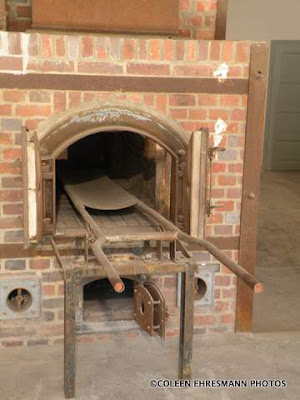
Dachau was not the first concentration camp, but it was the first State Concentration Camp, and the model for all the camps to come after. Originally, it was to relieve the overcrowding of political prisoners and foreigners in the prisons.

the only entrance for the compound

"work sets you free"

early uniforms of the prisoners
notice the posture & fitness of the men
"Prisoners had to line up mornings and evenings on the roll-call area to be counted. Irrespective of the weather, they were forced stand at attention. This torture could drag on for hours." -The Dachau Concentration Camp, 1933-1945 text and photo documents from the exhibition

admissions, reception and SS office buildings

the room where the prisoners were registered and
relieved of any and all possessions, including their clothes

photo of the communal shower room

the only documented prisoner to escape Dachau
Hans Bieler, 1933
brought to the camp on April 25 and escaped on May 9
published the first atrocities of concentration camps

memorial wreath

art work (3 chain links) showing the patches worn by prisoners
each color signified a specific crime; political, Jewish,
homosexual, criminals, anti-socials, Gypsies, Jehovah Witnesses, etc.
some triangles were pointed up, others pointed down
some overlapped, creating the six-pointed star

International Monument sculpted by Nandor Glid
"The sculpture recalls human bodies entangled in barbed wire." -The Dachau Concentration Camp, 1933-1945 text and photo documents from the exhibition

the yard or roll call area
As we walked across this area after from the SS offices and reception building, I could feel the presence of the men (and later women) who stood in rows for hours in all weather, twice a day at 5:15 AM and 7 PM, awaiting to learn their fate.
But it was in the Barracks building when we saw the beds and learned how the camp grew from 5000 prisoners (the original intended population) to 6000 in 1938 to more than 40,000 in 1944, that I felt the weight of this place...


three levels of bunks with separated 'bed' sections
1933 replica

1938 replica
less wood used, two men on each of three levels
no bed separation

replica of bunks in 1943
This visual had a very profound effect on me. As we listened to our guide describe the conditions of open windows to let the air move through in all seasons, no showers, crowded conditions, food allotment, and many other details I was both appalled at the cruelty of humans and amazed at the human spirit to survive.
Up until the summer of 1944, only men were housed at Dachau, but after the closing of some of the sub camps around Dachau, some 7000, mostly Jewish women, were sent to this main camp.
"Women were subjected to the same harsh conditions of imprisonment as men. But women also had to bear the added degradation of sexual violence, of constant disrobing, of physical examination to determine their fitness for work, and the lack of hygienic facilities." -The Dachau Concentration Camp, 1933-1945 text and photo documents from the exhibition

34 barracks built in 1938
30 of them held the prisoners
4 were dedicated to medical facilities

Catholic Memorial
just one of four or five
Just off to the east of the last of the 34 barracks, over a water-filled ditch and behind a row of trees...


the first crematorium, two furnaces
too small to accommodate the camp's population


four large furnaces



stages for cremation started on the far end of the building
with disrobing (so the uniforms could be used again),
shower room/gas chamber and then furnace room


Jewish Memorial

one of the mass graves


Pistol Range and a Blood Ditch
And finally the most inspiring and promising part of this sad, sad place...


Unknown Inmate by Fritz Koelle
first memorial at Dachau
The sculpture is everything the prisoners (while in camp) were not: looking up and out, not down; clothes, not a uniform; hands in his pockets, not as his side; feet apart, not together...

"To honor the dead, to admonish the living."


display boards at the site

memorial to the 4000 Soviet soldiers killed here
names of several hundred are listed
research continues to name more of those killed


area where the Soviet soldiers disembarked
and were shot in the short bunkers to the right
1941-1945

one of a half-dozen long shooting ranges

picture of the maintenance buildings during the time as
an SS Shooting Range/Training Facility


today those buildings are a homeless shelter

And at the end of the lane to the shooting range
a reminder that it is fall, another season and life goes on
Added note: I have visited the Holocaust Memorial Museum in Washington DC and that visit left a very lasting impression. This summer I read Lilac Girls and a few years ago The Book Thief, and there have been other books with a WWII theme. The visit to Dachau seems to have tied it all together, especially after reading Lilac Girls. Dachau and the other concentration camp memorials are a 'gift' of the German people "To honor the dead, to admonish the living." I have a better understanding of HOW and WHY it happened and pray it will never happen again.
Coleen, thanks for sharing this. It brought tears to my eyes. The inhumanity of it all.
ReplyDeleteGoosebumps reading this and seeing photos. Thanks for sharing
ReplyDelete